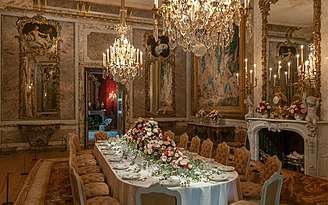Victorian cuisine
Victorian cuisine is the cuisine that was widespread in England during the Victorian era (20 June 1837 until her death on 22 January 1901).
Dining experience
The ideal Victorian woman, ‘the Angel of the House’, was a female who made the household attractive and comfortable for everyone in the family, and provided medical, spiritual and physical care to its members.[1] This physical care took an artistic and liberating turn during this period when dining and cooking became fashionable pastimes.[1] Factors that encouraged this innovation were improvement in kitchen safety, availability of ingredients, and the influence of the female aesthetic.[2] With the new, positive view that “cooking was a high art practised by geniuses", middle and upper class Victorian women in began to express their culinary creativity for the first time, much as male artists had always been able to do.[2]
Company for dinner

Dining became an elaborate event that took planning and skill, Hosting fancy dinner parties was a new way to elevate social class in Victorian England artistically. Instead of cooks and servants, middle and upper class women began to make complicated dishes to impress family members and guests. This ultimately transformed the once mundane tasks of cooking and eating into artful experiences.[3]
With this trend, meals split into multiple courses. A bill of fare and a guideline to plan menus became popular.[4] A three course meal, for example, might begin with soups with fish, followed by meats, roasts or stews, then game and pastry, and ending with salads, cheese and liquor.[5] Setting the table was an important part of the dining aesthetic, involving expensive silverware and china, with table decorations of “glass, linen, fruits, foliage, flowers, colours, [and] lights".[5]
Cooking at home
Many Victorian meals were served at home as a family. Middle and upper class breakfasts typically consisted of porridge, eggs, fish and bacon. They were eaten together as a family. Sunday lunches included meat, potatoes, vegetables and gravy.[6] Family meals became common events that linked the comforts of home with this newly recognized art form.
Morality
Victorian cuisine did not appeal to everyone. Victorian England became known throughout Europe for its bland and unappetizing food. Victorians associated intense flavor with sexual desire, which they repressed. British chefs like Mrs. A. B. Marshall encouraged boiling and mutating food until it no longer tasted or resembled its original form.[2] Many housewives started cooking in this fashion since it was the only ‘safe’ way to encounter food.[2] By contrast, Elizabeth Robins Pennell was an evocative figure who promoted originality by encouraging women to become creative in the kitchen and by stating that “cooking is the ultimate form of art.”[2]
References
- Floyd, Janet. (2003). The recipe reader : narratives, contexts, traditions. Forster, Laurel, 1962-. Aldershot, Hants, England: Ashgate. ISBN 1351883194. OCLC 619863875.
- Floyd, Janet. (2010). The recipe reader : narratives, contexts, traditions. Forster, Laurel, 1962-. Lincoln: University of Nebraska Press. ISBN 9780803233614. OCLC 457150789.
- The recipe reader : narratives, contexts, traditions. Forster, Laurel., Floyd, Janet,, Forster, Laurel, 1962-. London. ISBN 9781351883191. OCLC 974642023.CS1 maint: others (link)
- ""How to eat like a Victorian"".
- DODS, Margaret, pseud. (1862). [The Cook and Housewife's Manual ... The fifth edition, revised and enlarged, etc.]. OCLC 559095562.
- ""How to eat like a Victorian". 2016-10-16. Retrieved 2019-04-14".